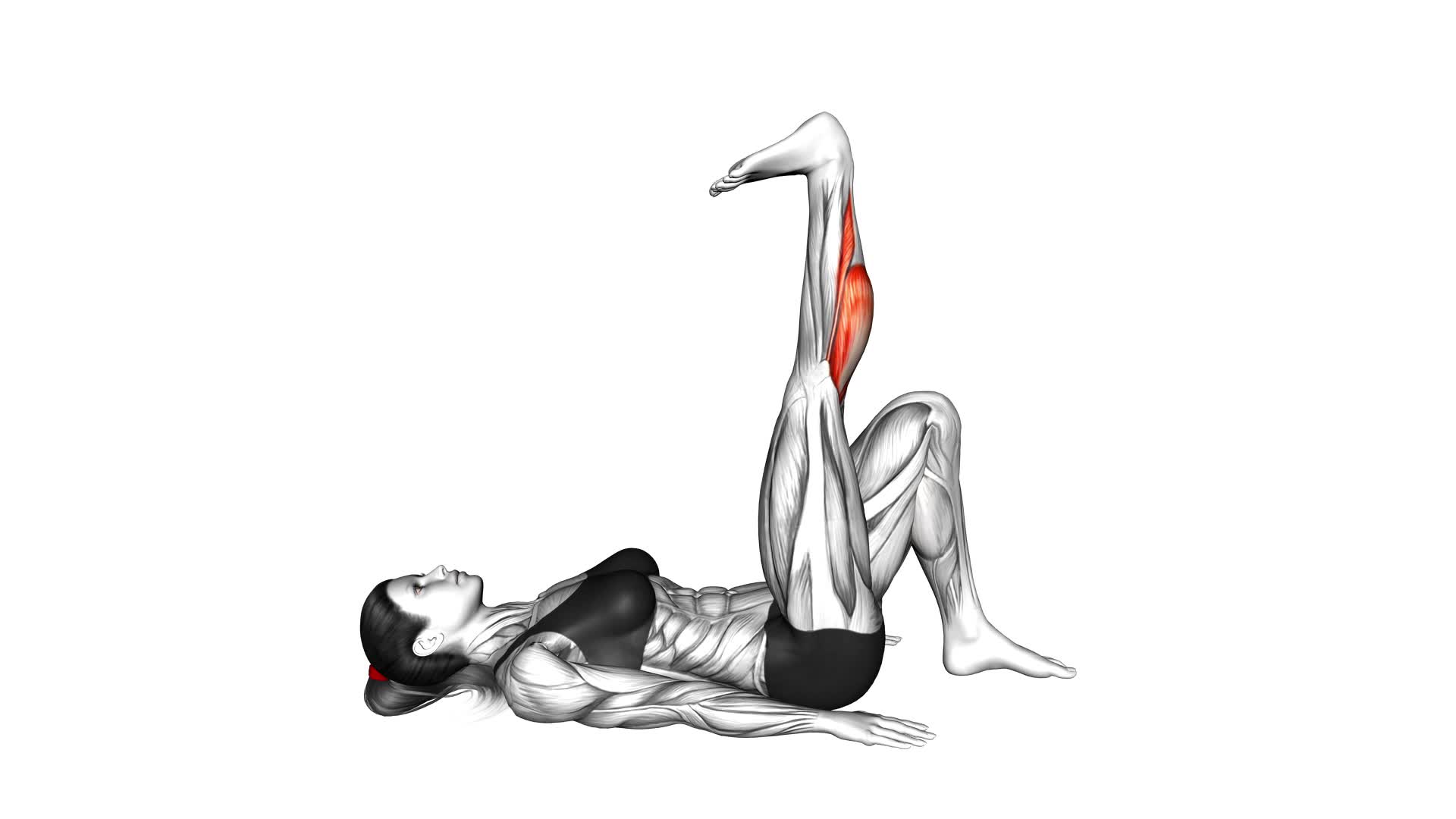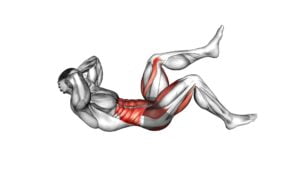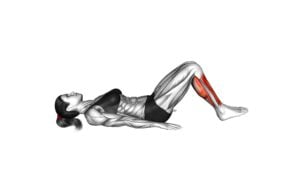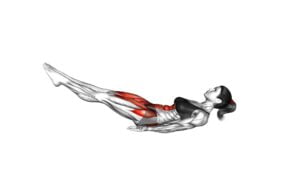Lying Single Toe Pointing (female) – Video Exercise Guide & Tips

Are you looking for a simple and effective exercise to strengthen your toes? Look no further than lying single toe pointing.
Watch This Exercise Video
This video exercise guide and tips will show you the proper form and technique, equipment needed, modifications, and common mistakes to avoid.
Maximize the effectiveness of this exercise with these helpful tips. Get ready to strengthen those toes and improve your overall foot health.
Let's dive in!
Key Takeaways
- Lying Single Toe Pointing improves balance, foot strength, and foot flexibility.
- It strengthens the muscles supporting balance and stability, leading to increased overall balance and stability.
- It helps prevent injuries related to poor balance and stability.
- Proper form and technique, such as maintaining straight alignment of legs and engaging muscles in the feet and lower legs, are crucial for this exercise.
Benefits of Lying Single Toe Pointing
You can experience significant improvement in your balance and foot strength through regular practice of lying single toe pointing. This exercise is a simple and effective way to enhance your balance and stability while also improving foot flexibility. By lying on your back with your legs extended and your toes pointed towards the ceiling, you activate the muscles in your feet and lower legs.
As you engage in this exercise, you'll notice increased flexibility in your feet and ankles. This improved foot flexibility can be beneficial in various activities such as dancing, running, and even everyday movements like walking or climbing stairs. Additionally, lying single toe pointing helps to strengthen the muscles that support your balance and stability.
By consistently incorporating this exercise into your routine, you can expect to see significant improvements in your overall balance and stability. This can have a positive impact on your performance in sports and activities that require coordination and agility. Moreover, it can also help prevent injuries related to poor balance and stability.
Proper Form and Technique
To ensure proper form and technique during lying single toe pointing exercise, it's important to maintain a straight alignment of your legs and engage the muscles in your feet and lower legs. Start by lying flat on your back with your legs extended in front of you. Keep your toes pointed upwards towards the ceiling and your legs straight. Avoid any bending or twisting of the legs during the exercise, as this can lead to improper form and decreased effectiveness.
One common error to watch out for is allowing your legs to drop or sag towards the ground. This can happen when your core muscles aren't engaged, so be sure to activate your abdominal muscles and keep your lower back pressed firmly against the floor. Another mistake is lifting your hips off the ground, as this takes the focus away from your legs and places unnecessary strain on your lower back.
For advanced variations, you can incorporate ankle weights or resistance bands to add extra resistance and challenge your muscles even more. This will help to increase the intensity of the exercise and promote further strength and flexibility gains.
Now that you understand the proper form and technique for lying single toe pointing, let's move on to the equipment needed for this exercise.
Equipment Needed for the Exercise
To properly execute the lying single toe pointing exercise and maximize its effectiveness, it's important to have the right equipment. While this exercise doesn't require any specific gear, having a few items on hand can enhance your workout experience.
One recommended gear is a yoga mat or an exercise mat to provide cushioning and support for your body while lying down. This will help prevent discomfort and potential injuries. Additionally, wearing comfortable workout clothes and supportive athletic shoes is necessary for stability and proper foot alignment during the exercise.
In terms of necessary equipment, you'll need a flat surface to lie on, such as a workout mat or carpeted floor. This ensures a stable and secure base for performing the exercise. You may also want to have a towel or small pillow nearby to provide additional support or cushioning for your head or lower back, if needed.
Modifications and Progressions
To modify or progress the lying single toe pointing exercise, you can incorporate variations that target different muscle groups or increase the intensity of the workout. Here are four modifications and advanced variations you can try:
- Single Leg Toe Pointing: Instead of keeping both legs extended, lift one leg off the ground and perform the toe pointing exercise with only one leg. This variation increases the challenge and engages the core and stabilizer muscles.
- Resistance Band Toe Pointing: Place a resistance band around your feet and hold the ends with your hands. As you point your toes, pull against the resistance of the band to add extra tension and work your leg muscles even more.
- Toe Pointing with Ankle Weights: Strap on ankle weights to add resistance and increase the difficulty of the exercise. This modification helps to strengthen your leg muscles and improve overall lower body strength.
- Toe Pointing on an Unstable Surface: Place a foam pad or balance disc under your lower back while performing the exercise. This unstable surface forces your muscles to work harder to maintain balance and stability.
By incorporating these modifications and advanced variations, you can challenge yourself and continue to progress in your lying single toe pointing exercise.
Now, let's move on to the next section and discuss common mistakes to avoid.
Common Mistakes to Avoid
What are some common mistakes you should avoid when performing the lying single toe pointing exercise? To ensure you get the most out of this exercise and prevent any potential injuries, it's important to be aware of these common mistakes and technique tips.
One common mistake is lifting your entire leg off the ground while pointing your toe. To avoid this, make sure to keep your leg relaxed and only focus on pointing your toe without lifting your leg.
Another mistake to watch out for is tensing your foot muscles too much, which can lead to cramping. Instead, try to find a balance between flexing and relaxing your foot muscles.
It is also important to maintain proper alignment during the exercise. Avoid letting your ankle roll inwards or outwards, as this can put unnecessary strain on your joints. Keep your ankle neutral and aligned with your leg.
Lastly, be mindful of your breathing. Some people tend to hold their breath while performing the exercise, which can cause tension in the body. Remember to breathe deeply and naturally throughout the movement.
Tips for Maximizing the Effectiveness of the Exercise
To maximize the effectiveness of the exercise, utilize proper form and engage your core muscles throughout the movement. Here are some tips for maximizing results, as well as variations and challenges to keep your workout interesting:
- Maintain proper form: Keep your body aligned in a straight line from head to toe. Avoid any excessive arching or rounding of the back.
- Engage your core: Throughout the exercise, focus on contracting your abdominal muscles. This won't only help stabilize your body but also increase the intensity of the exercise.
- Control your movements: Slowly point your toe and then return to the starting position in a controlled manner. This will ensure that you're targeting the right muscles and avoiding any unnecessary strain.
- Add variations and challenges: Once you have mastered the basic exercise, you can make it more challenging by adding ankle weights or resistance bands. You can also experiment with different leg positions or incorporate other exercises, such as leg lifts or bridges, to work different muscle groups.
Frequently Asked Questions
How Many Repetitions Should I Do for the Lying Single Toe Pointing Exercise?
For the lying single toe pointing exercise, it's important to focus on quality over quantity.
Start by doing a few repetitions and gradually increase as you get more comfortable.
Remember to listen to your body and stop if you feel any pain or discomfort.
This exercise helps improve flexibility and strength in your feet and ankles.
There are also modifications you can try to make it easier or more challenging.
Can I Perform the Lying Single Toe Pointing Exercise if I Have a Foot Injury?
Yes, if you have a foot injury, it's best to avoid the lying single toe pointing exercise as it may aggravate your condition.
Instead, focus on modifications to protect your injured foot. Try seated toe flexion and extension exercises or use a resistance band for ankle strengthening.
These alternative exercises will still work your foot muscles while minimizing strain on your injury.
Remember to consult with a healthcare professional for personalized advice.
Is It Necessary to Warm up Before Doing the Lying Single Toe Pointing Exercise?
Before performing the lying single toe pointing exercise, it's important for you to warm up. Warming up helps increase blood flow, flexibility, and prevents injury.
You can warm up by performing light cardio exercises or dynamic stretches.
If you're a beginner, you can modify the lying single toe pointing exercise by starting with a smaller range of motion or using a resistance band for support.
Remember to listen to your body and progress at your own pace.
Can I Do the Lying Single Toe Pointing Exercise on Any Surface?
Yes, you can do the lying single toe pointing exercise on any surface. It's important to find a comfortable spot where you can lie down and extend your leg.
Whether it's a mat, a carpet, or a yoga mat, make sure it provides enough support for your body.
Remember to follow the video exercise guide and tips for proper form and technique.
Keep practicing and enjoy the benefits of Lying Single Toe Pointing (female)!
How Long Should I Hold the Pointed Position During the Lying Single Toe Pointing Exercise?
To improve flexibility in the lying single toe pointing exercise, focus on how long you hold the pointed position. Avoid rushing through the movement and try to hold the position for at least 10-15 seconds. This will give your muscles time to stretch and increase your range of motion.
Common mistakes to avoid include not fully extending the leg and pointing the toes, as well as not engaging the core muscles. Remember to breathe and listen to your body's limits.
Conclusion
In conclusion, lying single toe pointing is a beneficial exercise for strengthening the muscles in the feet and ankles. By maintaining proper form and technique, using the necessary equipment, and avoiding common mistakes, you can maximize the effectiveness of this exercise.
Whether you're a beginner or looking for a challenge, modifications and progressions can be made to suit your fitness level. Incorporate this exercise into your routine to improve balance, stability, and overall foot health.

Author
Years ago, the spark of my life’s passion ignited in my mind the moment I stepped into the local gym for the first time. The inaugural bead of perspiration, the initial endeavor, the very first surge of endorphins, and a sense of pride that washed over me post-workout marked the beginning of my deep-seated interest in strength sports, fitness, and sports nutrition. This very curiosity blossomed rapidly into a profound fascination, propelling me to earn a Master’s degree in Physical Education from the Academy of Physical Education in Krakow, followed by a Sports Manager diploma from the Jagiellonian University. My journey of growth led me to gain more specialized qualifications, such as being a certified personal trainer with a focus on sports dietetics, a lifeguard, and an instructor for wellness and corrective gymnastics. Theoretical knowledge paired seamlessly with practical experience, reinforcing my belief that the transformation of individuals under my guidance was also a reflection of my personal growth. This belief holds true even today. Each day, I strive to push the boundaries and explore new realms. These realms gently elevate me to greater heights. The unique combination of passion for my field and the continuous quest for growth fuels my drive to break new ground.







